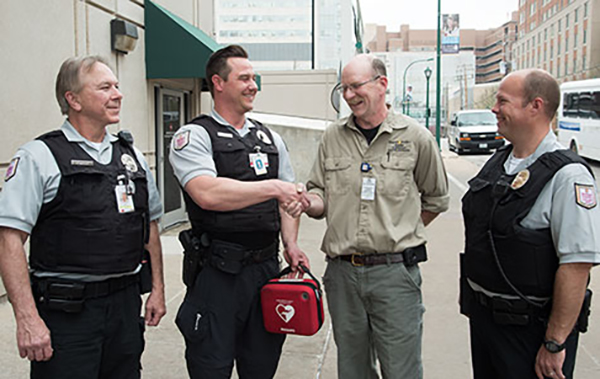
John VanderHeyden, a mechanic at Barnes-Jewish Hospital, said he is lucky to be alive after collapsing recently in a parking lot on the Medical Campus.
He was revived by Washington University School of Medicine security officers, who immediately began chest compressions and used an automated external defibrillator (AED), a portable device that provides an electric shock to restore a heart’s normal rhythm.
“This institution was smart enough to have this device and give the officers training,” said John VanderHeyden, who returned to work March 5. “They saved my life.”
Last December, as he and his wife, Beverly, a research technician in internal medicine, were about to get in their car, John fell to the ground. Beverly called 911, and School of Medicine protective services officers Mark Mallow, Scott Johnson and Robert Brooks arrived in minutes.
VanderHeyden is convinced that if he had gone into cardiac arrest at his home near Catawissa, Missouri, a small town an hour southwest of St. Louis, he would not be here to celebrate his 51st birthday next month.
The School of Medicine established its AED program in 2009, placing 135 AEDs in 22 buildings on campus. Security officers also have AEDs in their patrol vehicles. AEDs, which provide voice prompts and can be used by people who aren’t trained in their use, have become common in offices, shopping malls, airports and other locations where many people gather.
“This wonderful story of survival is precisely why we implemented the AED program,” said David Tan, MD, assistant professor of emergency medicine and medical director of the university’s AED program. “The quick action of the responding officers with the ability to deliver a life-saving shock from an AED allowed this man to return to his family. This is the outcome we all hope for when events like this occur.”
According to the American Heart Association, more than 1,000 people each day in the United States suffer cardiac arrest away from a hospital, including an average of 26 children. A person experiencing cardiac arrest has about four minutes in which to receive life-saving defibrillation. For every minute that passes without a heartbeat, the chance of survival decreases by 7 to 10 percent.
After his cardiac arrest, VanderHeyden was treated in the intensive care unit at Barnes-Jewish Hospital and received a defibrillator to regulate his heartbeat.
He said he’ll always be grateful to the security officers who saved his life.
“I know I was lucky,” VanderHeyden added. “I hope they feel really good about what they did.”
Comments and respectful dialogue are encouraged, but content will be moderated. Please, no personal attacks, obscenity or profanity, selling of commercial products, or endorsements of political candidates or positions. We reserve the right to remove any inappropriate comments. We also cannot address individual medical concerns or provide medical advice in this forum.